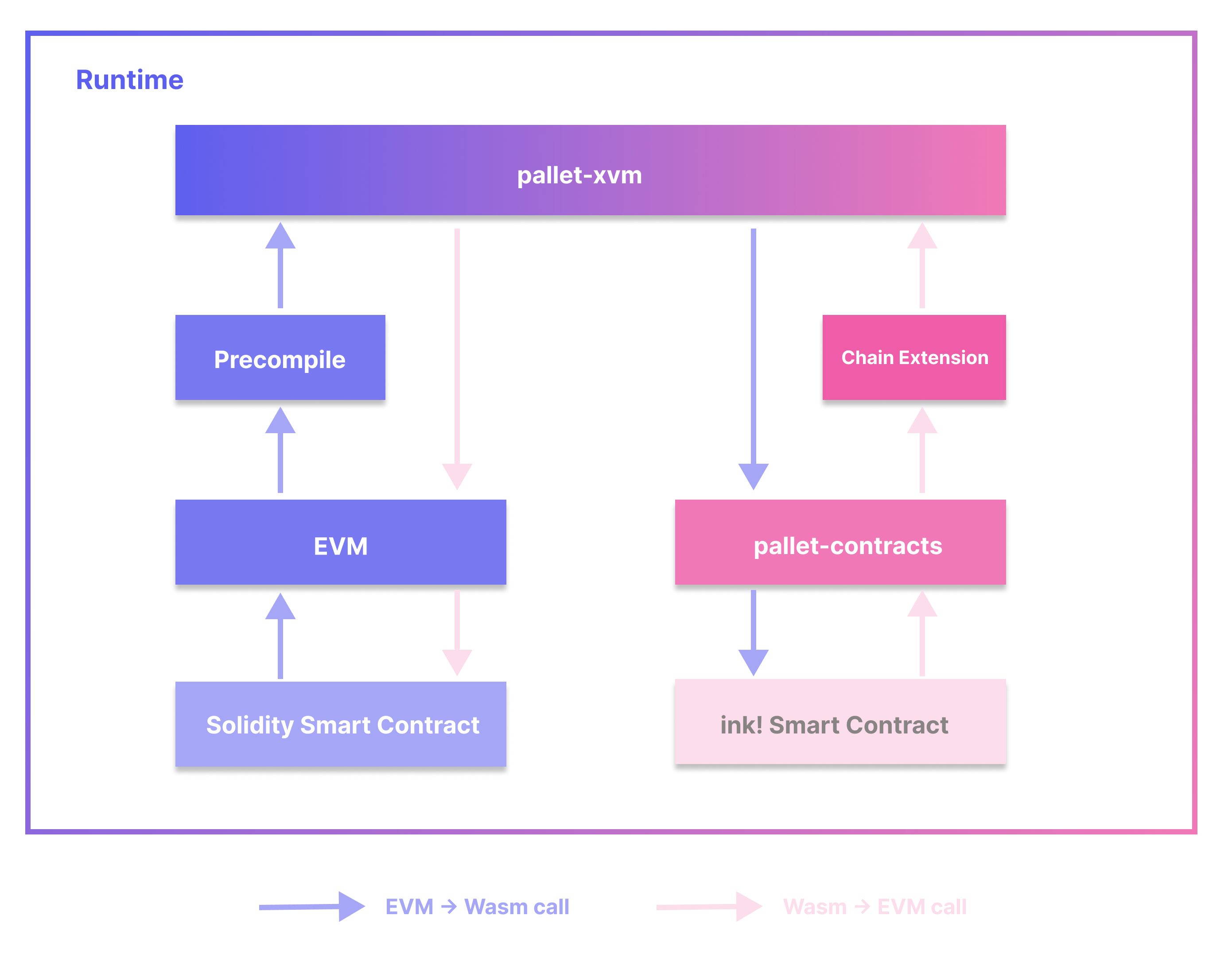XVM
Note that at this time XVM features are only launched in Shibuya testnet. Stay tuned for Shiden and Astar!
Intro: Multiple VMs as one; one VM for all
As a smart contract platform, Astar Network currently supports both EVM and Wasm (WebAssembly) contracts. Based on specific needs, developers are free to build on either VM. This brings both flexibility for builders and larger groups of users to Astar Network. But the Astar team doesn’t just stop there. Even better, our multi-VM solution, XVM, is introduced to bring true interoperability between different VMs.
XVM allows smart contracts in different VMs to work together seamlessly. A smart contract in EVM can call a Wasm contract just like it’s another EVM contract and verse visa. From either EVM or Wasm perspective, contracts in different VMs can work together like they are in one: the XVM.
Architecture

Components
The XVM architecture contains five main components:
pallet-xvm: the hub module to call EVM or Wasm.- XVM precompile: a custom precompile that allows EVM contracts to call
pallet-xvm. - Chain extension: the interface that allows ink! contracts to call
pallet-xvm - EVM: Astar EVM implementation, which is Ethereum compatible.
pallet-contracts: the VM for ink! smart contracts.
pallet-xvm module is the core part of XVM. It provides functions to allow other components to call EVM or Wasm, while XVM precompile and chain extension play the role of gateways for contracts to call the pallet-xvm module.
Cross-VM calls
A typical XVM cross-VM call could be either:
- Call from EVM into Wasm, or
- Call from Wasm into EVM
For calls from EVM into Wasm, the call will be initiated by smart contracts in EVM. The call path is: EVM contract -> precompile -> pallet-xvm -> Wasm.
For calls from Wasm into EVM, the call will be initiated by smart contracts in Wasm. The call path is: Wasm contract -> chain extension -> pallet-xvm -> EVM.
Note that only calling from one VM to another is allowed. Calling the contracts within the same VM will be reverted with an error.
Interfaces
For Solidity EVM contracts, the XVM interface is defined as follows:
interface XVM {
function xvm_call(
uint8 vm_id,
bytes calldata to,
bytes calldata input,
uint256 value,
uint256 storage_deposit_limit
) external payable returns (bool success, bytes memory data);
}
For ink! Wasm contracts, XVM can be called with chain extension:
pub type CallResult = u32;
#[ink::chain_extension]
pub trait XvmCall {
type ErrorCode = u32;
#[ink(extension = 0x00010001, handle_status = false)]
fn call(vm_id: u8, target: Vec<u8>, input: Vec<u8>, value: u128) -> CallResult;
}
EVM and Wasm contracts have a similar interface for XVM calls. The common arguments they share:
vm_id: ID of the target VM to call. Use0x0Fto call EVM and0x1Fto call Wasm.to: the address of the target contract. For EVM contracts, it’s aH160bytes. For Wasm it’sAccountId32bytes.input: the encoded call arguments.value: the amount of native token to transfer, used for payable calls.
Note that in the context of caller VM, the caller address is always the address of the caller contract, instead of the user address. For instance, Alice calls an EVM smart contract ContractA that calls into an ink! contract, within the ink! contract’s call, the self.env.caller is ContractA address instead of Alice.
input encoding
As mentioned above, input of encoded arguments is needed for XVM calls. The encoding specification depends on which VM to call.
For calls to EVM (0x0F as VM Id), refer to here for Solidity ABI specifications and here for examples.
For calls to Wasm (0x1F as VM Id), the input is encoded as: selector_bytes ++ scale_encoded_args.
Gaps between EVM and Wasm contracts
In the case of calling from EVM to Wasm, to call XVM in EVM, an extra parameter storage_deposit_limit is needed. It is required by pallet-contracts, to specify the maximum storage deposit to pay storage rent. As mentioned above, as the caller’s address is always a contract address instead of a user, it’s the caller contract’s address that pays for the storage rent. For Solidity contracts that call Wasm contracts via XVM, developers need to make sure the contract has enough balance for the payment, or the call fails. To pass a sufficient storage_deposit_limit value, developers need to know how much is required from the caller contract. For instance, they can benchmark the target call and get the limit in worst-case scenario N, and pass 2 x N for margin of safety.
Another worth mentioning gap for payable calls from EVM to Wasm is the concept of ED(existential deposit) in pallet-contracts. Using the pallet-balances in Substrate for payable calls, pallet-contracts assumes all addresses, including EVM contracts address, need to meet the minimum balance requirement to keep alive (which is not true as there are no ED requirements in EVM). As mentioned above, the caller address is always the calling contract, for payable calls from EVM to Wasm, developers need to make sure their EVM contract address meets the ED requirement, otherwise, the payable call will fail in Wasm and be reverted.
Error handling
The errors incurred in XVM calls bubble up from the caller VM to the caller VM. If an error is returned in either EVM or Wasm, the whole XVM call will be reverted.